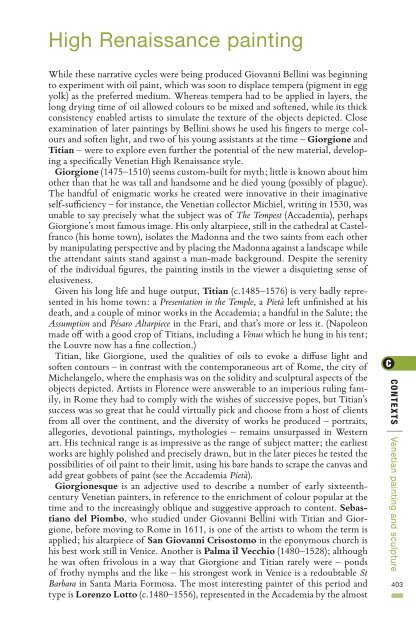Create successful ePaper yourself
Turn your PDF publications into a flip-book with our unique Google optimized e-Paper software.
High Renaissance painting<br />
While <strong>the</strong>se narrative cycles were being produced Giovanni Bellini was beginning<br />
<strong>to</strong> experiment with oil paint, which was soon <strong>to</strong> displace tempera (pigment in egg<br />
yolk) as <strong>the</strong> preferred medium. Whereas tempera had <strong>to</strong> be applied in layers, <strong>the</strong><br />
long drying time of oil allowed colours <strong>to</strong> be mixed <strong>and</strong> softened, while its thick<br />
consistency enabled artists <strong>to</strong> simulate <strong>the</strong> texture of <strong>the</strong> objects depicted. Close<br />
examination of later paintings by Bellini shows he used his fingers <strong>to</strong> merge colours<br />
<strong>and</strong> soften light, <strong>and</strong> two of his young assistants at <strong>the</strong> time – Giorgione <strong>and</strong><br />
Titian – were <strong>to</strong> explore even fur<strong>the</strong>r <strong>the</strong> potential of <strong>the</strong> new material, developing<br />
a specifically Venetian High Renaissance style.<br />
Giorgione (1475–1510) seems cus<strong>to</strong>m-built for myth; little is known about him<br />
o<strong>the</strong>r than that he was tall <strong>and</strong> h<strong>and</strong>some <strong>and</strong> he died young (possibly of plague).<br />
<strong>The</strong> h<strong>and</strong>ful of enigmatic works he created were innovative in <strong>the</strong>ir imaginative<br />
self-sufficiency – for instance, <strong>the</strong> Venetian collec<strong>to</strong>r Michiel, writing in 1530, was<br />
unable <strong>to</strong> say precisely what <strong>the</strong> subject was of <strong>The</strong> Tempest (Accademia), perhaps<br />
Giorgione’s most famous image. His only altarpiece, still in <strong>the</strong> ca<strong>the</strong>dral at Castelfranco<br />
(his home <strong>to</strong>wn), isolates <strong>the</strong> Madonna <strong>and</strong> <strong>the</strong> two saints from each o<strong>the</strong>r<br />
by manipulating perspective <strong>and</strong> by placing <strong>the</strong> Madonna against a l<strong>and</strong>scape while<br />
<strong>the</strong> attendant saints st<strong>and</strong> against a man-made background. Despite <strong>the</strong> serenity<br />
of <strong>the</strong> individual figures, <strong>the</strong> painting instils in <strong>the</strong> viewer a disquieting sense of<br />
elusiveness.<br />
Given his long life <strong>and</strong> huge output, Titian (c.1485–1576) is very badly represented<br />
in his home <strong>to</strong>wn: a Presentation in <strong>the</strong> Temple, a Pietà left unfinished at his<br />
death, <strong>and</strong> a couple of minor works in <strong>the</strong> Accademia; a h<strong>and</strong>ful in <strong>the</strong> Salute; <strong>the</strong><br />
Assumption <strong>and</strong> Pésaro Altarpiece in <strong>the</strong> Frari, <strong>and</strong> that’s more or less it. (Napoleon<br />
made off with a good crop of Titians, including a Venus which he hung in his tent;<br />
<strong>the</strong> Louvre now has a fine collection.)<br />
Titian, like Giorgione, used <strong>the</strong> qualities of oils <strong>to</strong> evoke a diffuse light <strong>and</strong><br />
soften con<strong>to</strong>urs – in contrast with <strong>the</strong> contemporaneous art of Rome, <strong>the</strong> city of<br />
Michelangelo, where <strong>the</strong> emphasis was on <strong>the</strong> solidity <strong>and</strong> sculptural aspects of <strong>the</strong><br />
objects depicted. Artists in Florence were answerable <strong>to</strong> an imperious ruling family,<br />
in Rome <strong>the</strong>y had <strong>to</strong> comply with <strong>the</strong> wishes of successive popes, but Titian’s<br />
success was so great that he could virtually pick <strong>and</strong> choose from a host of clients<br />
from all over <strong>the</strong> continent, <strong>and</strong> <strong>the</strong> diversity of works he produced – portraits,<br />
allegories, devotional paintings, mythologies – remains unsurpassed in Western<br />
art. His technical range is as impressive as <strong>the</strong> range of subject matter; <strong>the</strong> earliest<br />
works are highly polished <strong>and</strong> precisely drawn, but in <strong>the</strong> later pieces he tested <strong>the</strong><br />
possibilities of oil paint <strong>to</strong> <strong>the</strong>ir limit, using his bare h<strong>and</strong>s <strong>to</strong> scrape <strong>the</strong> canvas <strong>and</strong><br />
add great gobbets of paint (see <strong>the</strong> Accademia Pietà).<br />
Giorgionesque is an adjective used <strong>to</strong> describe a number of early sixteenthcentury<br />
Venetian painters, in reference <strong>to</strong> <strong>the</strong> enrichment of colour popular at <strong>the</strong><br />
time <strong>and</strong> <strong>to</strong> <strong>the</strong> increasingly oblique <strong>and</strong> suggestive approach <strong>to</strong> content. Sebastiano<br />
del Piombo, who studied under Giovanni Bellini with Titian <strong>and</strong> Giorgione,<br />
before moving <strong>to</strong> Rome in 1611, is one of <strong>the</strong> artists <strong>to</strong> whom <strong>the</strong> term is<br />
applied; his altarpiece of San Giovanni Crisos<strong>to</strong>mo in <strong>the</strong> eponymous church is<br />
his best work still in <strong>Venice</strong>. Ano<strong>the</strong>r is Palma il Vecchio (1480–1528); although<br />
he was often frivolous in a way that Giorgione <strong>and</strong> Titian rarely were – ponds<br />
of frothy nymphs <strong>and</strong> <strong>the</strong> like – his strongest work in <strong>Venice</strong> is a redoubtable St<br />
Barbara in Santa Maria Formosa. <strong>The</strong> most interesting painter of this period <strong>and</strong><br />
type is Lorenzo Lot<strong>to</strong> (c.1480–1556), represented in <strong>the</strong> Accademia by <strong>the</strong> almost<br />
CONTEXTS<br />
|<br />
Venetian painting <strong>and</strong> sculpture<br />
403







